All of the Free Plugins from Klanghelm!
Klanghelm Offers These 3 Free Plugins:
- DC1A - Compressor
- IVG12 - Saturator
- MJUC jr. - Tube Compressor
Free plugins are hit or miss - some are great, while others may not even load. Fortunately, Klanghelm has developed some fantastic and versatile free plugins.
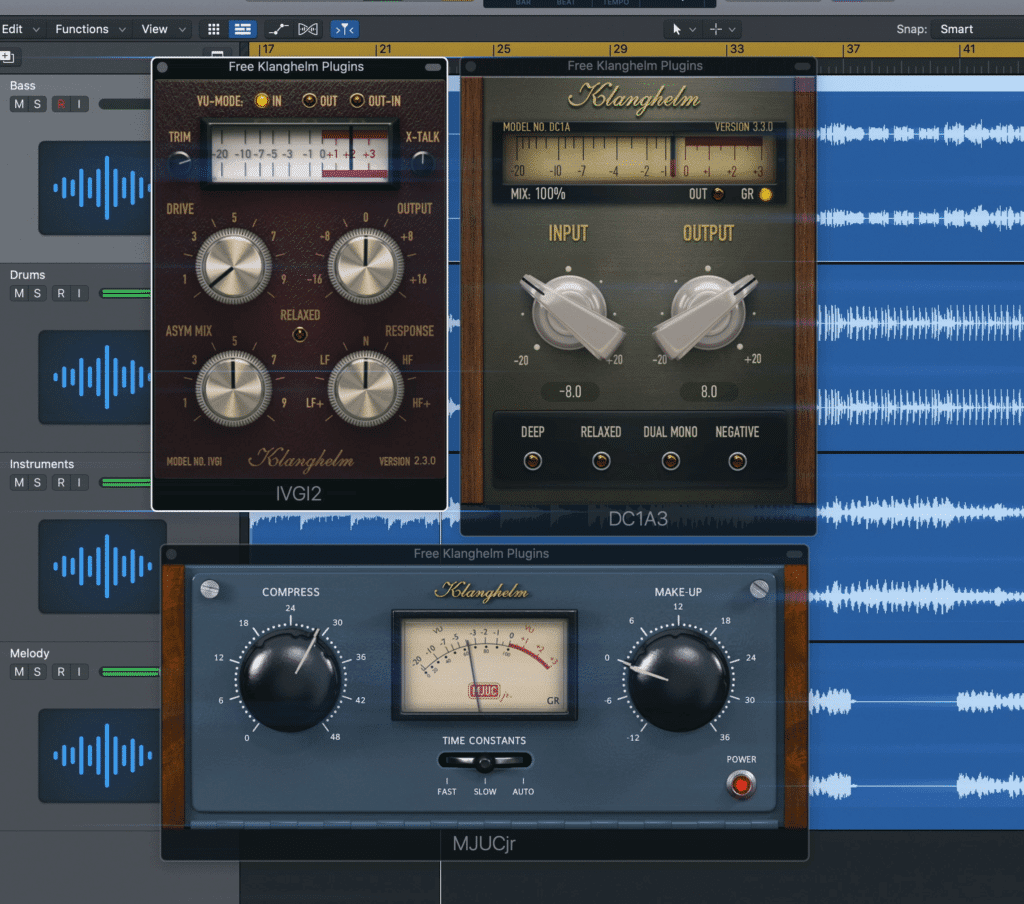
Here are 3 free plugins from Klanghelm.
Today, we’ll look at the 3 free plugins that they currently offer, discuss their functionality, and then showcase them on some various tracks to get a good idea of how they sound.
If you’re an artist or an engineer and you have a mix that you need to have mastered, send it to us here:
We’ll Master it for you and send you a free sample for you to review.
First, let’s cover the plugins’ functionality starting with the DC1A.
The Functionality of the DC1A
The DC1A is an incredibly simple and straightforward compressor, with limited functionality.
Starting with the metering section, we can switch between a gain reduction meter and an output meter. Additionally, clicking on the glass of the meter bypasses the plugin.
If you want to use this compressor for parallel compression, you can alter the mix percentage. At 0 the signal is completely dry as if you had bypassed the plugin. At 100% the compressor is in full effect.
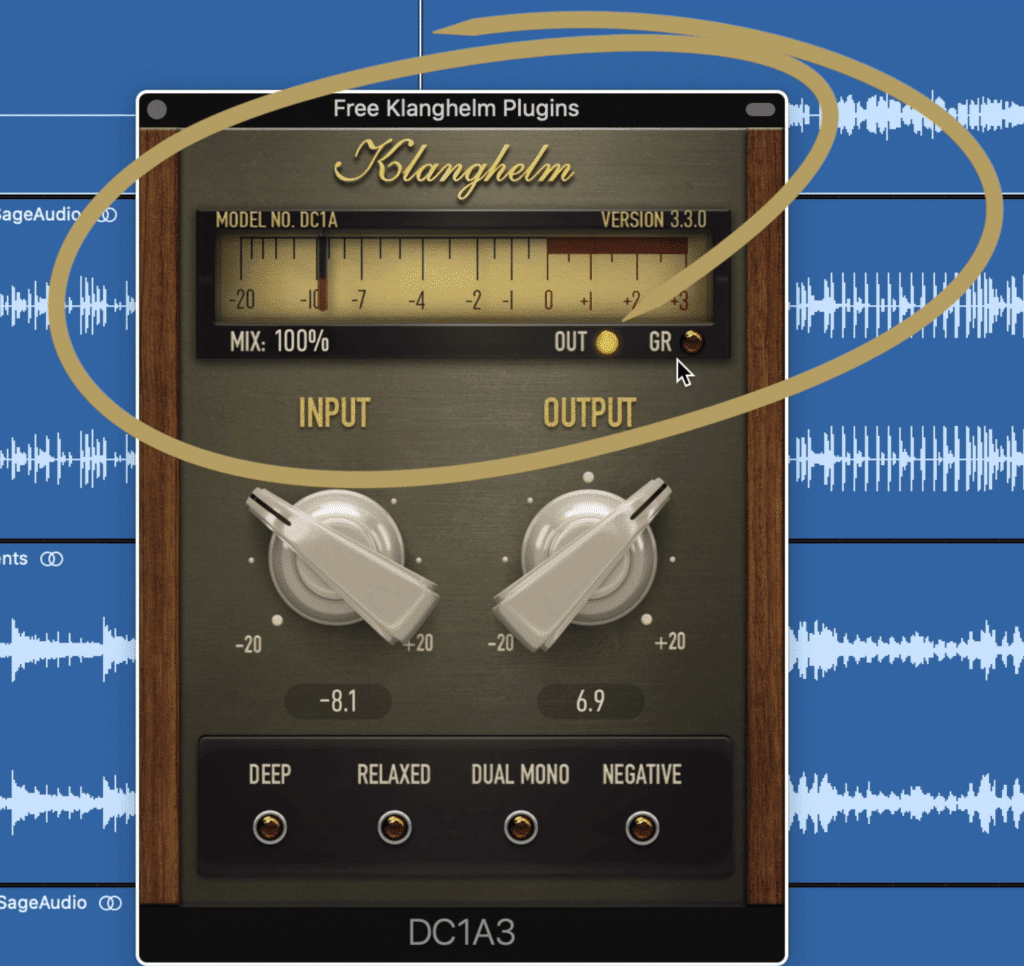
The metering section is up top and offers both an output level and gain reduction.
The input ranges from -20dB to 20dB and will engage a compressor once the signal becomes loud enough. Keep an eye on your gain reduction meter to find out where this is.

When using gain reduction metering, you can match the output to 0dBVU.
The output works like a typical output and ranges from -20dB to 20dB.
At the bottom of the plugin, we have 4 different settings we can engage.
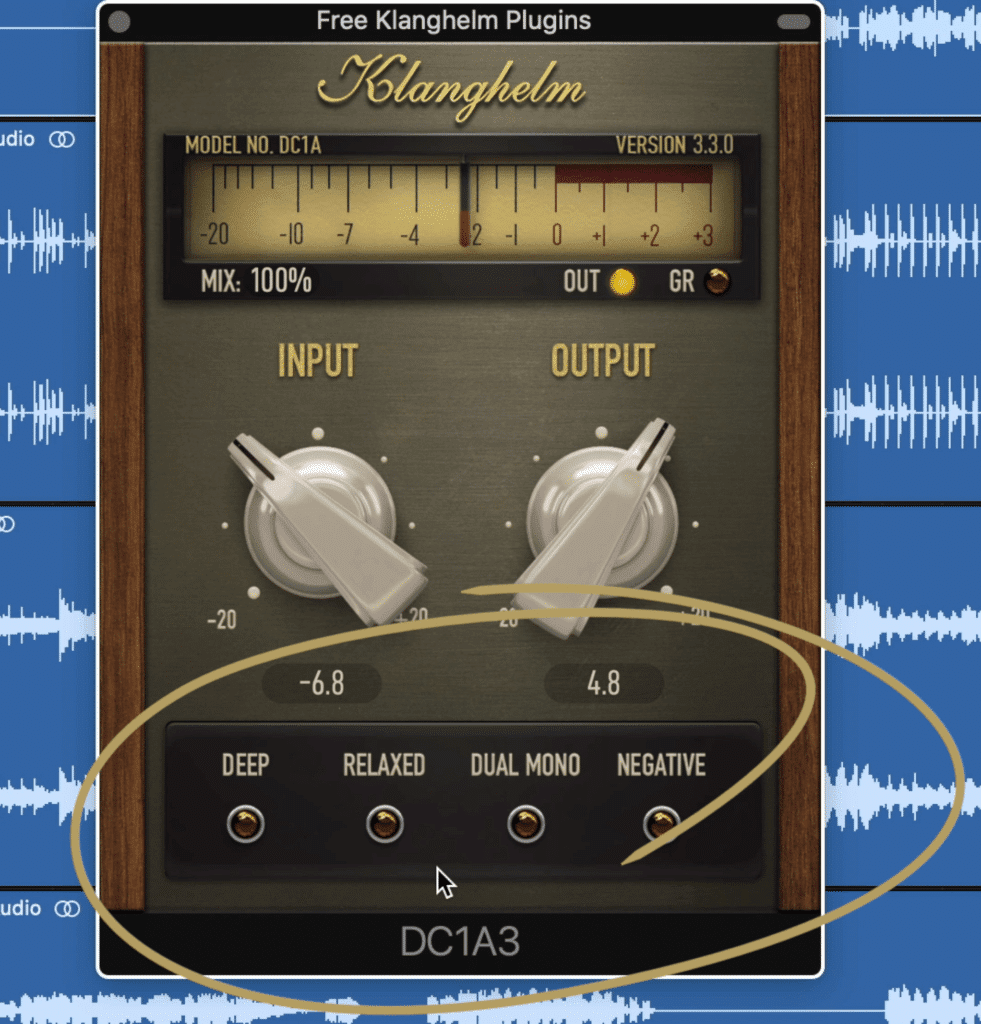
The both section includes 4 new settings that change the compression amount and timbre.
Deep engages a high-pass filter , which will ensure that the low-frequency range of the signal is not compressed. This is great when you want to preserve your bass and kick but you still need to compress a track.
Relaxed introduces less aggressive compression and saturation. When this is engaged, there is less harmonic distortion and less attenuation to the signal. This is useful if you’re using the compressor as a bus compressor.
As the name suggests, Dual mono converts a stereo signal into dual mono. This means that the left and right channels will be processed independently, possibly resulting in compression on one channel but not the other.
Lastly, negative creates some expansion when the input reaches an extreme setting. It does this by inverting the ratio of the compression. Again this only happens when the input reaches a higher portion of the threshold.
If you’d like to find some more free plugins specifically designed for master, check out our video on the topic:
In the video, we detail 10 great free plugins that can augment your masters.
IVG12 - Saturator
The IVGI2 is a comprehensive saturator with a lot going on behind the scenes. It may look pretty simple, but know that all of its functions are slightly modulated to create a variable, somewhat random effect to the saturation.
Starting with the metering, we have 3 options:
- Input
- Output
- Output - Input
The output minus input is interesting since it shows the difference between your input and output in RMS. This way you can adjust your output to compensate for any gain changes caused by saturation.
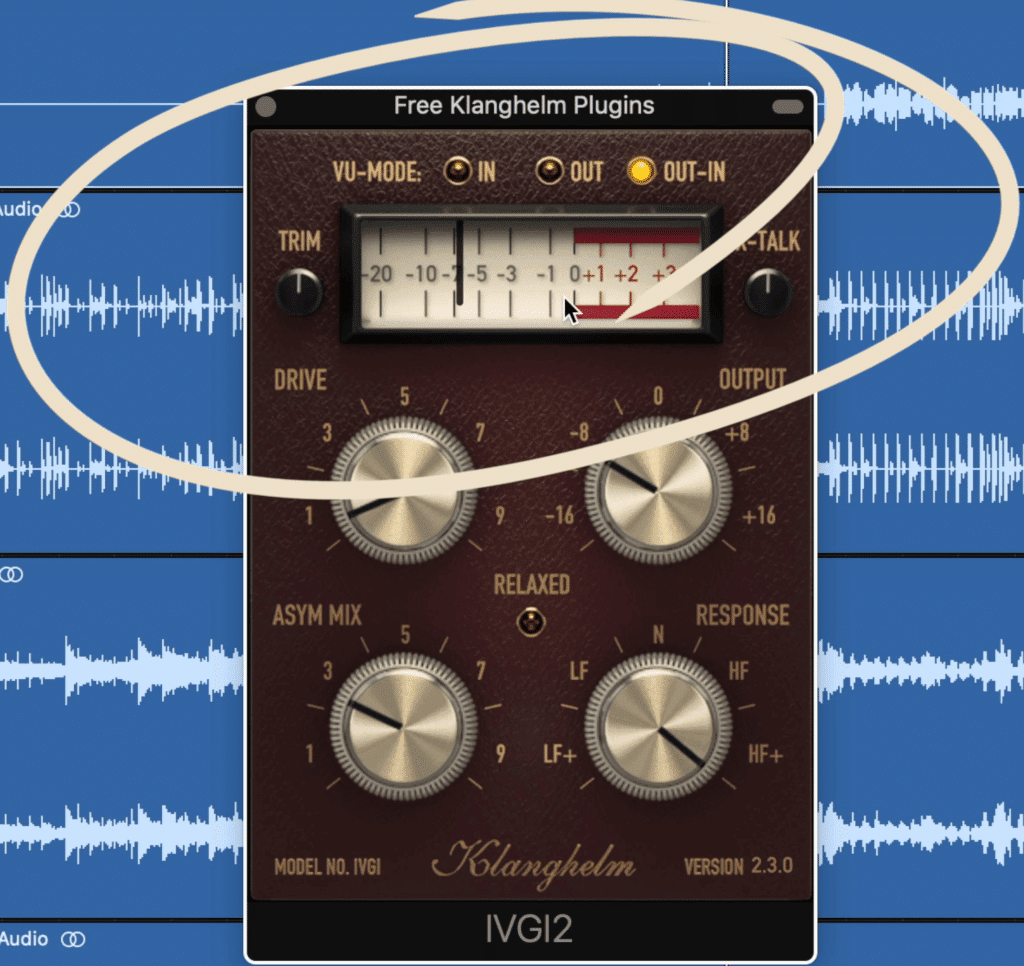
Up top are 3 meters, an input, output, and output minus input.
Additionally, you can bypass the plugin by clicking the glass meter.
Trim is your input - Klanghelm recommends adjusting this dial until the signal is peaking at about 0dbVU.
The Drive rotary adjusts the amount of saturation. When you increase this dial you increase harmonic distortion and soft-knee compression.
The Asymmetrical mix dial is interesting. When the ASYM dial is set to the far left, the compression settings are symmetrical - meaning stronger compression will occur. This compression has a more aggressive and noticeable effect on the timbre of the signal.
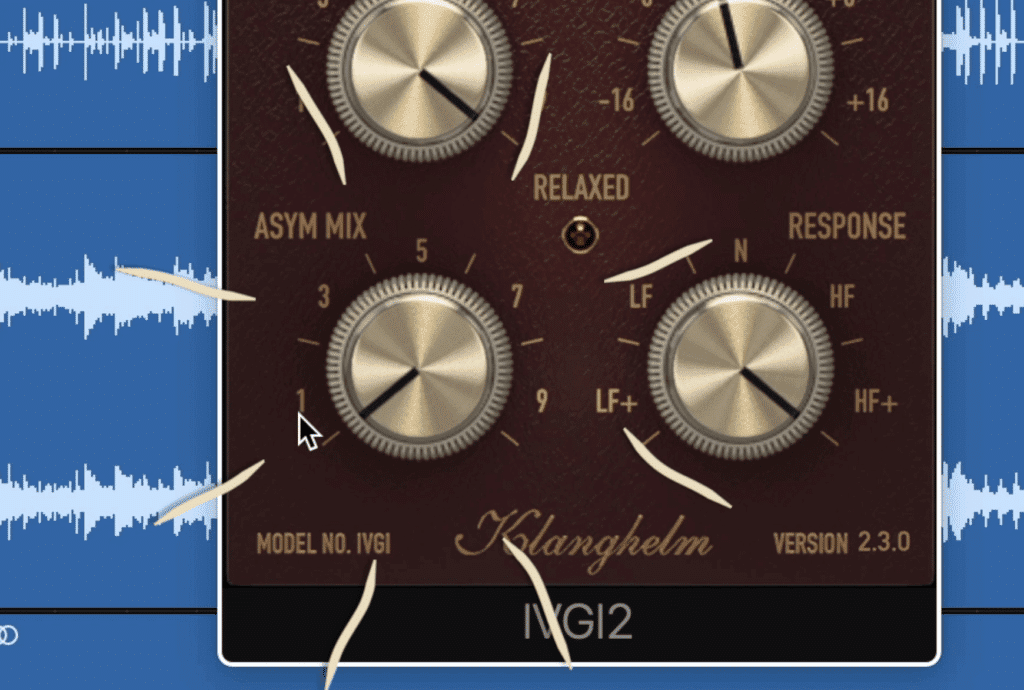
Asym mix lets you control how much compression occurs.
The opposite is true when you turn the dial to the far right. In this setting, the compression is less aggressive and more transparent.
The frequency response function is possibly the most complex and uses a lot of behind the scenes processing to accomplish. Using an emphasis-deemphasis equalization technique , the IVGI2 accomplishes frequency-specific compression and saturation.
The default is neutral meaning all frequencies are affected in an identical manner.
The LF+ focuses the compression and saturation on the low frequencies, as well as introduces a slight bump to the low end , and a roll-off of the high end. This makes it great for compressing bass guitars and kick drums.
HF+ does the same to the high end by boosting the high-frequency range and reducing the lows. This can be used for de-essing since the frequencies will be compressed and then reintroduced with a subtle shelf.
The relaxed function introduces a different algorithm, and like the relax function on the DC1A, calms the sound down by using less aggressive distortion and compression.
Lastly, the crosstalk function blends the left and right signals by introducing a portion of each into the other channel. So a small amount of the right channel ends up in the left and vice versa.
MJUC jr. - Tube Compressor
For a very simple compressor with a lot of character the MJUC jr. A compressor with tube-like characteristics, the MJUC jr. offers subtle harmonic distortion and unique curves.
On the left side of the plugin is the compression dial, with which you can increase the amount of compression. The ratio is set, so increasing this compression dial really means lowering your threshold.
In the middle of the plugin is the meter, which can be switched between gain reduction, and the output level by clicking the small text in its bottom right corner. Like the other 2 plugins we covered, the plugin can be bypassed by clicking the glass display of the meter, or by clicking the red light in the bottom right of the plugin.

This dial is more or less your threshold with a pre set ratio.
Underneath the meter is the time constants, which can be varied from Fast, Slow, and Auto.
Fast uses a fast attack and fast release, slow uses a slow attack and fast release, and auto uses a fast attack and automated release.

The time constants change the attack and release settings.
On the right is your make up gain. Use this in conjunction with your gain reduction meter to find the right level to set this to.
Lastly, by clicking the Klanghelm icon you open up the plugin’s credits and global settings. In it, you can affect things like the dial sensitivity, and meter’s speed.

The make-up gain has a range of 48dB.
Due to this plugin’s simplicity and ease of use, it’s a great first, not-stock-plugin compressor to use. But it’s subtle but pleasant sound makes it suitable for any engineer.
If you’d like to find some more free plugins, check out our video on the topic:
In the video, we detail 10 great free plugins that can augment your mixes.
Conclusion
Any one of these plugins would make a great addition to your collection. Each offers well-designed and thought out analog emulation settings meant to bring some character to your mixes.
Although you could use these plugins on individual instruments, they also make for great parallel and bus compressors.
Try these plugins out for yourself and let us know if they improved your mixes - we’d love to hear your thoughts.
If you’re an artist or an engineer and you have a mix that you need mastered, send it to us here:
We’ll Master it for you and send you a free sample for you to review.




